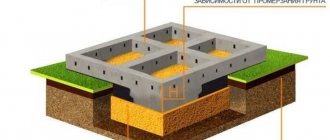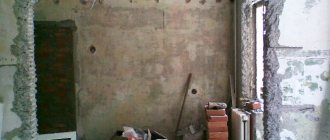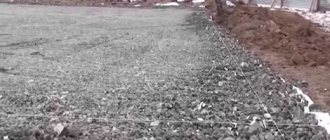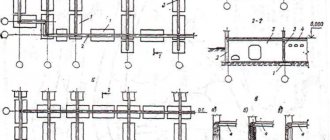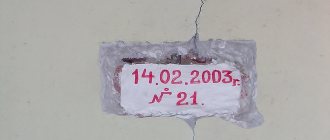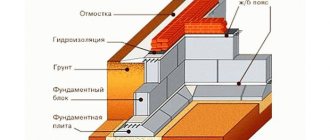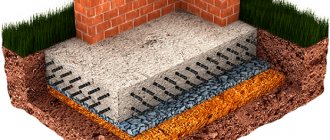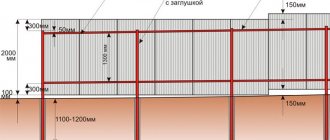The foundation cushion is a special layer between the base and the soil surface, which can be made of sand, crushed stone, precast or monolithic concrete. Bulk materials are placed in a layer in a pre-dug trench and carefully compacted, concrete is poured in accordance with all rules, blocks are carefully laid and fastened.
The reliability, strength, and durability of the building largely depend on the correct execution of the foundation design. The foundation cushion is one of the most important elements, thanks to which it is possible to create a flat and stable platform in order to reduce the settlement of the structure and compensate for the characteristics of the soil.
The foundation cushion performs the following functions:
- The surface on which it is planned to build the foundation and the entire structure is leveled, so that the load from the structure is evenly distributed onto the ground.
- It is possible to eliminate the possibility of contact between the foundation and the soil by laying a layer of sand, gravel or concrete between it and the ground.
- Sand foundation pads protect reinforced concrete foundations from the effects of wet soil.
Why do you need a base underlay?
The installation of a pillow under the foundation is one of the mandatory stages of building a house, in accordance with established rules and regulations. If everything is done correctly, the structure will last for many years.
Otherwise (if the pillow is abandoned altogether or the task is implemented incorrectly), the building may soon begin to deteriorate: distortions appear in the window/door openings, the walls become covered with cracks, and there are drafts inside.
A properly designed and executed foundation pad, the dimensions of which are carefully calculated and correspond to the future building, will eliminate ground subsidence, reduce the load on the soil from the walls of the house, and raise the lower part of the structure above the groundwater level. The base is thus protected from the effects of soil water, is not eroded, and the pressure on the foundation is uniform.
When thinking about why a foundation cushion is needed, it is worth taking into account cases when there is a layer/section of soil on the site that is unsuitable for construction. Then the soil is removed, and sand, gravel are poured into the trench, and reinforced concrete is poured or laid.
What thickness should it be for different materials
The thickness of the backfill layer recommended for the construction of a strip foundation depends on external factors. The parameters of the building (weight, dimensions) and soil properties (composition, groundwater level, amount of frost heave) are taken into account . The determination of the pillow parameters is carried out when calculating the foundation; this is a complex engineering task, accessible only to trained and competent specialists.
When using sand backfill, the most common layer thickness is in the range of 25-60 cm. The upper limit of layer thickness is taken to be three times the width of the tape, but such values are usually never reached.
The material is laid in layers of 20 cm and thoroughly compacted. To increase compaction density, the pad is moistened with water.
A crushed stone cushion can consist of different types of material:
- Limestone.
- Gravel.
- Granite crushed stone.
The most popular fraction is 20-40 mm. The minimum layer thickness is 25 cm. It is laid on a sandy preparatory layer of 15-20 cm, which must be taken into account when calculating the depth of the trench.
The sand is moistened and thoroughly compacted, after which crushed stone is laid with moistening and compaction.
All work is carried out with the utmost care.
The density of the bedding layer, according to SNiP, must be at least 1.6 t/m3, which requires the use of construction equipment (or at least hard work with a manual tamper or roller).
Making your own pillow
Before making a pillow for the foundation, you need to carefully consider all stages of the work and decide on the material. The cushion can be made of sand, gravel, a mixture of these two materials, as well as monolithic/precast concrete.
To level the bottom of the pit/trench, add sand or gravel in a layer of 10 centimeters. Concreting is relevant where there is a need to expand the base or reinforce the belt for laying FSB blocks. It’s not difficult to do all the work yourself, you just need to remember some nuances.
How to make a pillow for the foundation:
- The embankment of the sand base should be lower than the foundation, the width should be 2 times greater than the similar parameter of the base. For leveling, crushed stone bedding is made with a layer of 30 centimeters in this way: a third of sand and 2/3 of gravel.
- After leveling the bottom of the pit, they make a cushion - first lay a layer of sand, spill it with water, and tamp it thoroughly and for a long time. Gravel is also laid.
- If a concrete pad is being made for the foundation, the work is carried out as follows: crushed stone is poured onto a flat area in a layer of up to 10 centimeters and compacted. Then the formwork is constructed according to the required design parameters, reinforced with reinforcement (horizontal and vertical, which connects the foundation to the walls), and concrete mortar is poured.
- For a crushed stone cushion, the bottom of the pit or trench is filled in such a way that the finished base reaches the level in the project.
The most durable, reliable and durable option is considered to be a monolithic concrete pad under a strip foundation. Despite some difficulties and length of the process, filling everything yourself is quite possible.
In this case, the thickness of the pillow should be 30 centimeters greater than the base, and also 30 centimeters wider (15 centimeters on both sides).
General rules for constructing a foundation cushion
We found out why this element is needed. Now let's look at the basic rules of construction, where to start in order to build a reliable foundation for a load-bearing structure.
The materials are laid in layers, with periodic compaction. For manual tamping, layers of five to ten centimeters are arranged; when using vibrating plates, this figure increases by five centimeters.
Many people are interested in the question of why to lay a cushion under the entire foundation. This measure will ensure uniform settlement of the building.
The dimensions of the width of the pillows in relation to the same value of the strip foundation are made thirty centimeters larger.
Installation features
When installing ENIR foundation pads, it is necessary to take into account some points:
- Before laying, leveling should be done using a building level. This will avoid the need to level the foundation.
- It is better to use slabs of the same brand, especially when constructing permanent walls of a construction site.
- It is important to carry out the installation with a dressing. This must be done so that the vertical seams of the rows are not adjacent. To achieve this, blocks of different lengths are used.
A reinforced concrete panel house is installed on foundation pads if a strip base for the house is used. In this case, elements of a certain volume are foundation blocks.
At the same time, GOST states that it is better to install FL exactly the same as building blocks. The procedure consists of the following steps:
- The future site is being prepared for the construction of a house on it and a trench is being dug.
- The entire surface of the dug hole is leveled, and with the help of special equipment the lower plane is compacted.
- Place sand, and crushed stone on top of it and compact it thoroughly.
- After the calculations of the FL and their dimensions are completed, the slabs and blocks are brought to the construction site.
- The slabs are installed using a construction crane, since it is impossible to lift them manually.
- After the assembly is completed, the blocks are reinforced.
- After the foundation pads for FBS are laid, they are bandaged.
- Cover the surface with waterproofing materials to avoid moisture penetration and backfill.
To build a prefabricated foundation, it is necessary to use only those block elements whose dimensions and strength comply with GOST.
Reinforcement with reinforcement
Providing the necessary strength is achieved by reinforcement produced according to one of the following design solutions:
- single-layer mesh, woven structure;
- welded two-layer mesh frame.
Foundation blocks mainly transfer the load to stable soil layers or to a prepared pad
The first option is used for narrow slabs up to 1.6 meters wide, and the second option is used for standard sizes of products increased to 3.2 meters.
The standard obliges, when installing a flat mesh or volumetric reinforcement frame, to maintain a distance from the reinforcement to the outer surface of at least 30 millimeters. A layer of concrete of the specified thickness will reliably protect steel reinforcement from the penetration of moisture, the destructive effects of corrosion.
To ensure the immobility of the reinforcement, non-metallic spacers must be used. The wire sizes differ depending on the design of the rigging devices and the number of attachment points. Its diameter ranges from 4 mm (for assortment BP-I) to 14 mm, corresponding to wire A-III.
Steel reinforcement, securely concreted in the cushion, comes out and forms a mounting loop. This element is necessary for movement during installation. The installation diagram for the rigging brackets is given in the appendix to this standard. The document regulates six options for fastening elements depending on the mass of the slab.
Intermediate layer thickness
The thickness of the cushion made of bulk materials should be at least 30 centimeters: usually 10 centimeters is sand and the rest is made of crushed stone. The concrete pad is also poured with a thickness of at least 30 centimeters so that it is wider than the foundation itself.
Taking into account the fact that the width of the concrete base must be the same or greater than the thickness of the wall (which is not enough to bear the loads), a trapezoidal structure is often made to save money.
To avoid the need to fill a wide cushion and the same foundation (which will entail considerable costs), an expansion is arranged in the recessed part.
As a rule, the angles of inclination of the side walls are 30-45 degrees, depending on the type of foundation itself (concrete or brick). The trapezoidal shape of the structure makes it possible to eliminate dangerous shearing or tensile stresses on the side faces. The lower expanded part does not allow the foundation to move out of the soil and neutralizes the effects of tangential heaving forces during frosts.
The trapezoidal base significantly reduces costs by reducing the volume of reinforcement and concrete mixture. And the foundation turns out to be reliable, durable, with excellent load-bearing capabilities.
Dimensions: width, height, thickness
In order for the pillow to satisfy all the requirements, it is necessary to choose its dimensions correctly - width, length, thickness. They depend on the structure of the cushion itself, the load-bearing capacity and heaving of the soil, the type of foundation and the massiveness of the structure.
The width and length of the pillow is determined by the dimensions of the foundation . In the case of a strip foundation, backfilling is carried out along the entire length of the trench, and the width of the strip should exceed the thickness of the foundation strip by at least 7-10 cm on each side. The minimum permissible backfill width is 25 mm.
When a slab foundation is erected, a cushion is formed over the entire area of the bottom of the pit. Its dimensions should exceed the dimensions of the slab by 15-20 cm in all directions. For columnar supports, the size of the pillow exceeds the base of the column by 20-25 cm.
The correct choice of the thickness of the compensation cushion is especially important when planning a shallow strip foundation. It is laid above the freezing depth of the soil, and therefore reacts most noticeably to heaving.
The following proportions are used in the calculation:
- with a concrete tape width of up to 65 mm - Н=1.2В (where Н is the thickness of the cushion, В is the width of the tape);
- with a foundation width in the range of 70-95 mm - H=1.15V;
- with a width of up to 100-125 mm - H = 1.1V.
When the width of the concrete strip is over 125 mm, it is considered that there is no need for a compensation layer. The pillow is filled only to level the surface and with a drainage function. In this case, it is enough to have a layer of 25-40 cm.
Based on these recommendations, then with a foundation width of 50 cm, a pillow 60 cm thick is required . It is this thickness that will provide reliable protection against swelling. In this case, the pillow is usually made of a sand-crushed stone mixture. The sand content in it must be at least 30%.
Types of pillows
Depending on whether the cushion is made under a slab foundation (FBS) or under concrete, the optimal material for the layer and its main characteristics (thickness, height, hardening, etc.) are selected. Before arranging a cushion, it is necessary to carefully study the soil at the site and perform all calculations. Traditionally, the foundation cushion is made of sand, crushed stone, precast/monolithic concrete.
Sandy
When thinking about how to make a cushion under a concrete slab or strip foundation, sand is most often chosen as the easiest to work with and affordable material.
When is a sand cushion relevant:
- The building is supposed to be built as a one-story building, which makes the opportunity to reduce waste quite justifiable.
- The house is built from lightweight material.
- The groundwater level is deep (provided that the groundwater is close, drainage is required).
When calculating the foundation cushion, you need to take into account that only coarse sand is suitable for this type of work. Fine sand cannot be used.
Things to remember when filling your pillow:
- The surface of the pillow should be made as smooth as possible, checking with appropriate tools.
- The layer of sand must be compacted thoroughly and for a long time.
- The optimal thickness of the sand cushion is 20-40 centimeters.
From crushed stone
Crushed stone is usually used where significant loads on the foundation are expected. Crushed stone is chosen in different fractions, rocks can also be anything. But the most durable support will be crushed granite of the middle fraction.
How to make a foundation cushion from crushed stone:
- First, the surface of the trench or ditch is sprinkled with a small layer (5-10 centimeters) of sand to ensure a tighter fit of the crushed stone to the ground.
- The sand is carefully leveled and compacted well.
- Crushed stone of the required fraction is poured in a layer, the thickness of which is up to 20 centimeters.
- The crushed stone backfill is carefully compacted using the appropriate tool.
The crushed stone cushion should be at least 30 centimeters wider than the base, which will ensure stability and the ability to withstand the considerable weight of the building.
Concrete
The concrete pad for the house can be prefabricated or monolithic. The team is made from special trapezoidal blocks produced in a factory. This is the most reliable support for large stone houses. True, the cost of this option is quite high.
How to lay prefabricated concrete pads:
- First, carefully level the soil.
- Sand is poured in a layer of up to 50 centimeters (the exact figure depends on the characteristics of the construction site and the soil).
- The foundation blocks of the pillow are installed.
A reinforced concrete pad made in this way is very strong, durable, and capable of withstanding severe loads. In Moscow, purchasing blocks will not be difficult, as in the regions. Manufacturers offer products of different prices, parameters, with or without delivery to the site.
How to pour monolithic concrete pads under the foundation:
- Preparing the soil surface - leveling, removing everything that gets in the way.
- Filling with crushed stone in a layer maximum 10 centimeters high.
- Compacting crushed stone using a vibrating plate.
- Installation of wooden formwork around the entire perimeter of the foundation. The height of the structure is equal to the thickness of the concrete layer, the upper level coincides with the zero level of the base.
- Laying horizontal and vertical reinforcement frames to strengthen the structure.
- Pouring concrete, compacting the layer, waiting for drying time and full strength gain.
Concrete foundation pads are made from C12-C15 concrete. You can pour it not only into the formwork, but also directly into the ground. The height of the reinforced layer is at least 40 centimeters in order to withstand compressive loads and not deform.
Reinforcement is usually made using steel rods, which are connected with knitting wire and placed horizontally and vertically. By tying the rods together, it is possible to ensure their immobility inside the formwork before and monolithic structure after pouring.
Why do you need a pillow under the foundation?
Many people know that a foundation built with violations creates impossible living conditions. The walls begin to become covered with cracks, blocks of windows and doors become warped, and drafts appear in the rooms.
Therefore, the rules of the device must be followed, and one of them is a pillow under the foundation. This load-bearing structure promotes optimal redistribution of load effects from the object and eliminates the phenomenon of subsidence. In addition, the foundation cushion makes it possible to raise the bottom of the supporting structure in relation to the groundwater level.
Most often, the artificial foundation is made of sand. Do not confuse the pillow with ordinary sand preparation, the layer of which is much thinner. The installation of a cushion under the foundation is carried out in order to improve weak or subsiding soil in order to replace the heaving soil composition with a non-heaving one directly under the foundation structure. The dimensional parameters and shapes of the pillow are determined taking into account the existing features.
Let's consider the need for arranging a pillow using the example of a layer formed from sand. It performs the following functions:
- alignment. This is the main purpose of a proper foundation cushion, since it helps level the bottom of a foundation trench or pit. The cushion must be poured under a slab foundation or under a FBS base, that is, under all prefabricated structures. Quite often, the bottom of the pit after construction equipment has unevenness, which, in order to save money, is leveled with sand;
- redistribution of load effects. Many experts claim that the pillow is able to distribute the load. But where? The fact is that the load forces are distributed evenly in any case - with or without a pillow. It is believed that the sandy base reduces the pressure on the soil composition and protects against possible soil movements, compensating for them;
- drainage functions. If you pour a sand cushion thirty centimeters thick under the foundation slabs, the capillary connections in the soil will be destroyed, and water will not flow into the foundation;
- protection against winter heaving. Sand drains water well, and it is best to replace heaving soils in order to give stable stability to the foundation structure. Just remember that the technology provides for drainage so that water accumulating in the sand does not aggravate the situation.
Now you know why you need a pillow under the foundation.
How to properly arrange a cushion of sand and crushed stone
Sand and crushed stone are currently considered a more accessible and cheaper option compared to precast/monolithic concrete. Provided the loads are not too heavy, sand and crushed stone are quite capable of providing excellent resistance to various loads, absorbing them and distributing them onto the ground. This choice will be ideal for a strip foundation:
The main advantages of a cushion made of sand and crushed stone:
- Simple and quick implementation of all activities, the ability to implement all stages with your own hands.
- Reduced thermal conductivity of materials, which allows you to retain heat inside the building.
- Reliability and density of the base, which has a positive effect on the entire building.
- Maximum uniform distribution of perceived loads of all types.
- Preventing the rise of moisture from the ground at the capillary level, protecting the entire structure from water.
How to properly make a pillow from sand and crushed stone:
- Preparation of a trench or ditch according to pre-made markings at the site.
- Leveling the bottom of the trench, compacting.
- Laying a layer of geological textile with a margin around the edges (then the pillow will be covered with these parts on top).
- Filling with a layer of coarse river sand, carefully leveling, moistening, compacting with a special tool.
- Filling with medium-fraction crushed stone in a layer of up to 20 centimeters, uniform distribution of the layer, compaction with a vibrating plate.
- Laying a layer of sand 20 centimeters high, pouring it with water. In this way, it is possible to achieve the penetration of sand particles into the voids between the crushed stone, which will provide greater density.
- Cover the pillow with the free edges of geotextile. To avoid damaging the material when performing further work, you can pour a little more sand on top.
Technology of work execution
Regardless of the material chosen, the pillow should be poured strictly according to the technology:
Sand
It is carried out according to this scheme:
- The bottom of the trench dug under the strip foundation should be leveled and compacted.
- If the soil is dusty or clayey, you need to remove a small layer and replace it with a stronger bedding, then level and compact it.
- A sheet of waterproofing material is laid at the bottom, which will protect the materials from ground moisture and prevent sand from mixing with the soil.
- For greater strength of the base, the bottom layer should be laid out with rubble (possibly in 2 layers).
- Sand is poured on top (as it is added, it must be moistened with water and compacted).
- Level the surface of the sand cushion using a platform vibrator or roller.
- The formwork for the foundation strip is installed on top of the cushion.
The height of the sand embankment depends on the characteristics of the soil and the features of the future building. In most cases, making it larger than 30 cm is impractical - stability will be lost.
The easiest way is to calculate the width of the tape that will be poured after installing the pillow. The height of the pillow should be three times the width of the tape. The width of the base is approximately 30 cm greater than the width of the tape.
Shchebnevaya
Sand is usually poured under the crushed stone . The process begins as when laying a simple sand cushion. But with a lower height of the sand embankment (10-15 cm).
After the sand has been compacted, crushed stone is poured on top of it. The height of the crushed stone layer should be up to 20 cm. The width of the crushed stone layer corresponds to the sand layer.
Other options for sand and crushed stone backfill are often used. For example, materials can be mixed and poured in a single layer.
You can make three layers:
- sand,
- crushed stone,
- sand.
Concrete
The use of a concrete pad involves leveling and compacting the bottom of the trench, as when using bulk materials. Then the waterproofing is laid, and a high sand cushion is poured on top. Another option is to pour 10-15 cm of crushed stone instead of sand.
Formwork is installed on top under a concrete base 10-15 cm high. It is reinforced and filled with concrete. Instead of pouring, you can use ready-made concrete slabs .
Concrete pad for slab foundation
A monolithic concrete pad for foundation blocks is the most durable and reliable foundation available. It is quite expensive and requires a lot of time and effort, but it is worth it, especially when it comes to building large, heavy houses.
How to pour a pillow under the foundation:
- Digging a pit according to the markings in accordance with previously performed calculations.
- Filling the pit with crushed stone in a layer of at least 10 centimeters, high-quality compaction with a vibrating plate.
- Construction of formwork up to 30 centimeters high along the entire perimeter of the base.
- Making a reinforcement frame from steel rods, which will ensure a longer service life and increase strength. The reinforcement is knitted with a mesh, the cells of which are 15 or 20 centimeters (square). Welding should not be used, as the structure will be less durable due to the seams. The reinforcement frame involves the presence of longitudinal rods located vertically and extending beyond the base, so that they can then be connected to other elements of the building.
- Filling with concrete mortar, compaction with a vibrator (at least using the bayonet method), which will remove voids in the monolith.
- Leveling the surface and carefully leveling it.
- The waiting time required for concrete to fully gain strength is about 28 days. Concrete must be properly maintained, depending on weather conditions.
A beautiful, durable and reliable building requires a proper foundation, which will not be strong without a well-equipped foundation. Provided the correct choice of materials and adherence to technology, all work can be completed quickly, accurately and with your own hands, saving on wages for workers and the use of special equipment.
Technology of concrete preparation for the foundation
This technology is not often used in ordinary residential construction, since the activities are quite labor-intensive and expensive. But it is precisely this that is considered the most durable among bases made from other compositions. Concrete preparation is arranged according to the same principle as the foundation of a building, only the layer will be several times thinner.
Filling the pillow consists of the following steps:
- Excavation.
- Laying and compacting the sand layer.
- Waterproofing device.
- Pouring a thin layer of cement.
- Construction of formwork.
- Laying out a horizontal reinforcing layer.
- Pouring a concrete pad.
- Bayoneting.
- Drying.
By adhering to this particular order of work, it is possible to guarantee the building’s resistance to earthquakes, soil erosion, soil freezing, sliding and subsidence of the foundation. With such preparation, the likelihood of cracks in the foundation, destruction of the house and failures is significantly reduced. The footing retains moisture in the solution that has not yet hardened. If water seeps into the soil, the hardening process is unlikely to proceed correctly, and the properties of concrete will not be fully revealed.
Purpose of the foundation pillow
If you do not follow the rules and regulations when laying the foundation, this can lead to serious consequences: the building will quickly become unusable and it will simply be impossible to live in it, since cracks will periodically appear on the walls, window frames and doors will be mowed, which will lead to permanent drafts That is why special attention must be paid to the quality of the base.
One of the main rules is the presence of a foundation base, which is the guarantor of a strong and reliable home. It helps create a normal load that falls on the lower part of the foundation itself. Such a solution would be very appropriate if it is necessary to raise the base relative to the groundwater level. Another argument in favor of its use is the absence of points of contact between the foundation itself and objects that could cause deformation of the base.
Sand bed work
